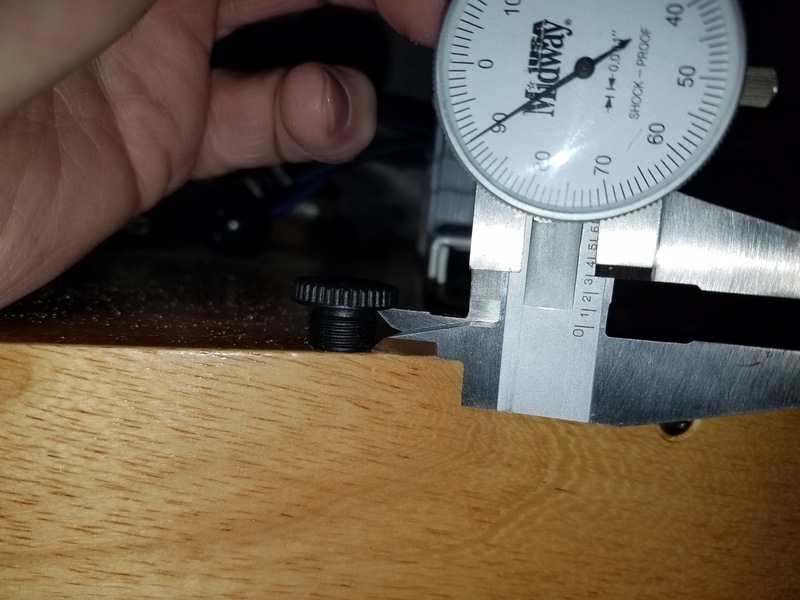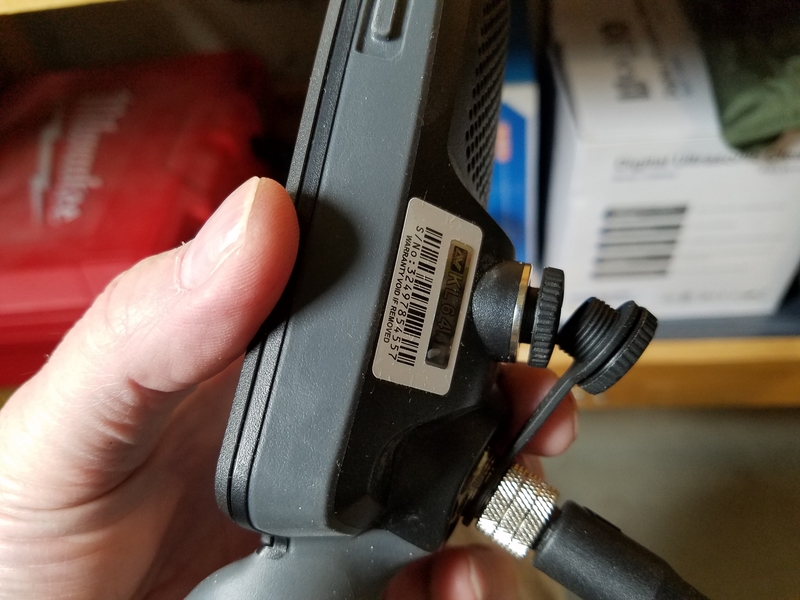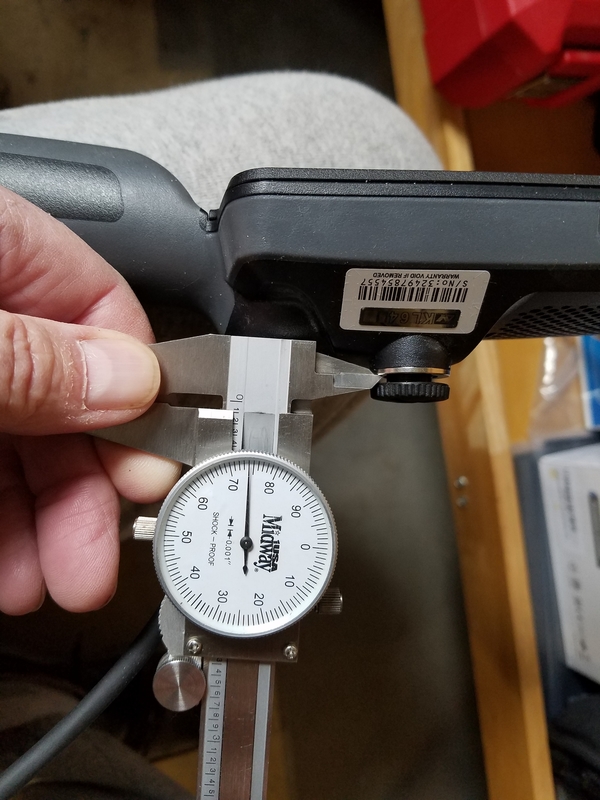-
Posts
154 -
Joined
-
Last visited
Content Type
Forums
Detector Prospector Home
Detector Database
Downloads
Everything posted by cdv
-
Glad you decided to share buddy! There is so much to learn on this machine and it takes someone to take the time and experiment with targets to figure out little nuances of the machine. Congrats on what I would say was a successful first hunt with the 800. Cliff
-
From all the measurements I just took looking at my dustcap and the 800's headphone jack, this could work IF properly sealed BUT it wouldn't work in the long run, you are dealing with plastic threads on the dustcap. Sealing between the dustcap and the headphone jack, after ensuring the headphone jack is properly inserted to make the connection and then adding a .075" thick rubber seal or O-ring and you would have a temporary accessory cable. Personally, I think I'll wait if I can't get the proper threaded connector to adapt. I'd hate to mess up a new machine that I've waited 6 months for.... Cliff
-

First Equinox 800 Hunt And Beginners Luck Strikes Gold!
cdv replied to Cal_Cobra's topic in Minelab Equinox Forum
Good video Cal and a real nice ring to start the Equinox off with! Congrats... Cliff -
Next weekend, if you don't have yours I'll give it a go... Cliff
-

Has Anyone Tried Non Minelab Bluetooth Earphones Yet Apt-x
cdv replied to NSC's topic in Minelab Equinox Forum
Wayfarer, thanks for that review, you save me having to return the Tronds due to my larger sized head..... Cliff -
Pretty much as I expected to hear......a lot of "energy" was lost on all the posts pertaining to the battery in the Equinox. Here is to hoping we continue to see that over 50% of the gloom and doom posts of the past 5 months continue to prove as wasted time! Thanks for the input Dan. Cliff
-
or is it just on my end? Here is all I see when I go there. Cliff 404 Not Found Page Not Found Sorry, the page you requested was not found You might be able to find the page your were looking for on the Sitemap Or try the Search page
-
Those words coming from Terry???? Wow! Cliff
-
Sure clears that up, thanks Steve... back to the drawing board IF Minelab doesn't have the accessory cord OR waterproof headphones available right away. Cliff
-

Steve, Is There A Waterproof Plug For The Nox....
cdv replied to Dan(NM)'s topic in Minelab Equinox Forum
Flat surface of the cap seals against the o-ring, that's all that is needed for what the machine is rated for! Thanks for the photos Steve!! Cliff -
"Our ongoing collaborative field testing feedback from around the world has resulted in further improvements" I have to wonder, how many changes they did make OTHER than to the Gold Mode. Cliff
-
https://www.minelab.com/usa/go-minelabbing/treasure-talk/equinox-technologies-part-3 Cliff EQUINOX Technologies (Part 3) January 15, 2018 Minelab Electronics This is the third instalment in a blog series introducing and explaining the technologies inside our new EQUINOX detectors… (Read Part 1 here. Read Part 2 here.) Our goal was to develop a true multi-purpose detector that could not only physically be used in all-terrain conditions, but also be suitable for all types of detecting for all detectorists, and particularly those not requiring a specialist premium flagship detector optimised for only one aspect of detecting – e.g. coins, beach, gold, jewellery, water, discrimination, artefacts, etc. This multi-purpose requirement is something that could only be achieved by going beyond single frequency and creating the next generation of multi-frequency technology. Equally adaptable to all target types and ground conditions – just select your detecting location and go! An important update on the Detect Modes… Previously we have stated that Park, Field and Beach would run in multi-frequency and that Gold would only use the single frequencies of 20kHz and 40kHz, giving better results for gold nugget hunting. Our ongoing collaborative field testing feedback from around the world has resulted in further improvements to Multi-IQ to the point where multi-frequency is now the best option for Gold Mode as well, and will be the default setting. Please refer to the revised Getting Started Guide for updated product functions. Now, back to the technology: looking into our Multi-IQ diagram further… a single frequency is most sensitive to a narrow range of targets and multiple frequency is equally sensitive to a wider range of targets (e.g. the orange curve versus the white curve below). According to Philip Wahrlich, “From our testing, the Multi-IQ deployed in EQUINOX detectors has shown no significant trade-offs relative to the best single-frequency detectors and exceeded performance benchmarks in many important attributes, especially discrimination. And, for good measure, EQUINOX can also be operated as a single-frequency detector” While we could delve into this aspect further, many of our readers are likely more interested in what happens within the white Multi-IQ band itself, rather than single versus multi. What has Minelab developed new, and uniquely, with frequencies to give better performance across the whole range of targets for different conditions? The Multi-IQ transmit signal used in EQUINOX is a complex waveform where multiple frequencies are combined in a very dissimilar way than our proven BBS/FBS technology in Excalibur II / Safari / E-TRAC / CTX 3030 detectors. If you view the BBS signal amplitude on an oscilloscope, it looks something like this: In comparison, Multi-IQ looks something like this: Hence – Multi-IQ is not a derivative or evolution of BBS/FBS. Multi-IQ is a DIFFERENT method of simultaneous multi-frequency metal detection. We could also debate “simultaneous” versus “sequential” semantics; however the real detection ‘magic’ doesn’t happen with what is transmitted to and received from the coil alone. Remember, in Part 2, we discussed how frequencies are “combined AND processed” as being important for achieving better results? Let’s assess Multi-IQ for the different Detect Mode search profiles: Park 1 and Field 1 process a lower weighted frequency combination, as well as using algorithms that maximise ground balancing for soil, to achieve the best signal to noise ratio. Hence being most suited for general detecting, coin hunting, etc. Park 2 and Field 2 process a higher weighted combination of the Multi-IQ band while still ground balancing for soil. Therefore they will be more sensitive to higher frequency (low conductive) targets, but potentially more susceptible to ground noise. Beach 1 also processes a lower weighted combination, BUT uses different algorithms to maximise ground balancing for salt. Hence being most suited for both dry and wet sand conditions. Beach 2 processes a very low weighted frequency combination, using the same algorithms as Beach 1 to maximise ground balancing for salt. This search profile is designed for use in the surf and underwater. Gold 1 and Gold 2 process the higher weighted combination of the Multi-IQ band while still ground balancing for soil. However, they use different setting parameters better suited for gold nugget hunting. Will Multi-IQ technology really obsolete all single frequency detectors? We’ll continue the discussion in Part 4…
-

Equinox In Wet Salt Sand. By Neil Jones.
cdv replied to Gerry Freeman-Smith's topic in Minelab Equinox Forum
Should we start the drum roll Steve? ? -
What I "think" I see here on the photo showing the rear of the speaker is: Three wires to the headphone jack....third wire to turn off internal speaker like the CTX when headphones are connected? Two wires to the charging port which makes sense for battery charging... but.....not sure if those also can be used for internet software uploads?? not big on computer related hardware. Guess that depends on where the two wires go inside on the boards. Cliff
-
Steve, you do have a way with words in describing details but it is your small post ending statements that sum up the story I like the best... can't wait to try this machine. Cliff
-

My Equinox " Coming Out " Statement
cdv replied to Steve Herschbach's topic in Minelab Equinox Forum
On the CTX, you could adjust Volume Gain (Target volume) and use it to your advantage as an assist in depth of targets. Some argued, set it on 30....we want to hear all targets, yet others (with good hearing and headphones) used it to their advantage for finding older coins at depth. Is there any magic the 800 can do to emulate the Volume Gain on the 3030? May be best in a separate thread? Keep up the info dumps as you can....although I don't post much, I'm a sponge when it comes to good information! Cliff -

Minelab CTX 3030 and GPZ 7000 Weight Comparisons
cdv replied to Steve Herschbach's topic in Minelab Metal Detectors
Thanks Steve that picture of the rod connection is just what I needed to see.... love to have options! Cliff -

Minelab CTX 3030 and GPZ 7000 Weight Comparisons
cdv replied to Steve Herschbach's topic in Minelab Metal Detectors
Steve, great post, just what I wanted to see....a side by side comparison. Since you have both, can you answer these questions... I am one of the ones that would spend the bucks for the lower rod to get some extra length but from what I see, you wouldn't be able to use the CTX lower rod with the lower piece of the GPZ shaft with the yoke right? I would have to purchase the complete lower rod assembly (2 piece) for the GPZ to get the extra length or find a way to remove the lower plastic assembly from the CTX lower rod.... Could you post a close up shot of how the GPZ lower rods connect? Can't wait to see the price of a GPZ lower rod, knowing the price of the CTX lower rod already!! Thanks Steve Cliff -

New Fisher F19 Detector
cdv replied to Rick K - First Member's topic in First Texas - Bounty Hunter, Fisher & Teknetics
Boost would be nice.....but I was so hoping for a new waterproof detector.... Cliff -

Garrett ATX Review - Beach Detecting In Hawaii
cdv replied to Steve Herschbach's topic in Garrett Metal Detectors
Hi Steve.... wondered how you did in Hawaii and was searching for the answers....totally forgot about this Forum that I had saved the link to... signed up just so I could reply..... That write up on the ATX was great.... I swear I learned more about the ATX from your write up than I have using it lately...admittedly, I have used it way less than the CTX so that is part of the reason... Hope you continue to have good success with the ATX.... and write about too! Cliff- 22 replies
-
- jewelry detecting
- garrett atx
-
(and 1 more)
Tagged with:





